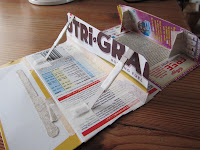I've read a fair few blogs running into issues with the windscreen frame fitting so wasn't really looking forward to it. Consulted with
Simon B on RHOCar & I found a blog with pictures of the process (on a 2B): Colin's 2B windscreen frame fitting (site no longer exists)
Glass into the frame
Inserted the flat rubber strip around the curved frame & cut it to the right length either side to allow the bottom rail to slide home. Then squirted a bead of washing up liquid around the rubber & worked it in with my finger.
I was expecting to need the ratchet straps to push the glass in, but it simply slid into place with gentle pressure & a little care on the corners where the rubber rippled:
Then the bottom rail, I used the same procedure - rubber strip inserted, a little washing up liquid and slide onto the bottom of the glass. This time I'm using the ratchet straps to hold everything steady while I consider the next step - fixing the bottom corners:
I don't know what I did different to other builders - Simon @ GBS said it should go together fine & pretty much it did!
Frame bottom corners
I toyed with the idea of a bracket on the outside of the frame, but in the end went for the GBS method on the corners. A diagonal self tapping (well wood screw) diagonally across the corner.
The only place to really trip up here is damaging the glass while drilling and fitting. So carefully angled a 3.2mm hole in from the side rail and into the centre of the bottom rail:
There's not much metal for the screw to grab so I also made a couple of reinforcing places from scraps of stainless. These slide into the bottom rail and gives the screw something solid/hard to grab:
This shot is just offering up the screw, I then measured the length required and cut the end of the screw so it only just protruded from the bottom hole:
Finishing
Once I knew the fixing method would work & the nearside held in the correct position I swapped to the offside side and duplicated the process. Although the bottom 'T' sealing strip can be slid into the grove in the bottom rail it means you cannot then see what you are doing to screw the corners in place - so - I screwed the corner together then carefully pushed the bottom rubber strip into its grove with a screwdriver:
The screw heads either side were mostly countersunk in place, but not too much to weaken the side frame. I used the Dremel & grinder head to smooth the screw heads flush with the frame. Theres just enough of the phillips head left meaning I could dismantle if I needed to:
Finally cut off the excess rubber strip with a sharp knife, as per Colin's advice angling the knife very slightly into the frame and taking care not to mark the glass:
Job done..
Fitting
I painted the windscreen uprights initially with brush on hammerite - mistake - too thick !
So sanded back and used hammerite black silk spray paint which gave a much nicer result. If the registration paperwork hadn't arrived I may have even got these powder-coated - but I need to get the car drivable while the weather holds!
The original wing mirror mounting holes were plugged with grommets, wing mirror stalks attached to the windscreen uprights and all bolted to the scuttle. My wife helped manoeuvre the windscreen assembly into place & its held either side with 5x flanged button head bolts which were already tapped into the frame and checked for length:
Very cool.. :)






















































